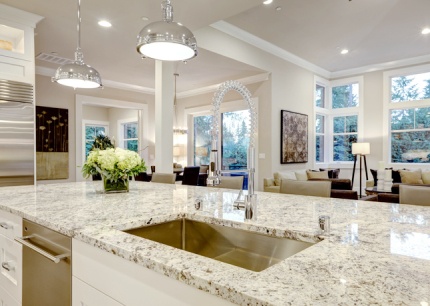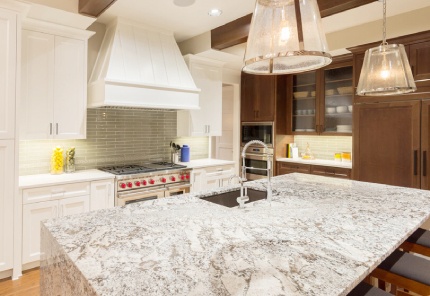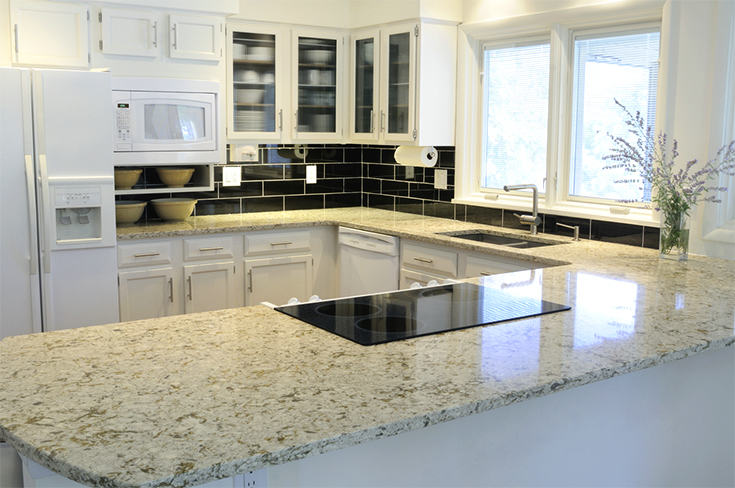Marble countertops have been a popular choice for kitchen remodelling for years. They add elegance, beauty, and a touch of luxury to any kitchen.
However, before making the decision to install marble countertops, it is essential to consider all the possible pros and cons.
In this article, we will discuss their advantages and disadvantages, maintenance, and how to choose the right one for your kitchen.
Advantages of Marble Countertops
 Marble countertops have been used in homes for centuries, and it’s not hard to see why. They offer a classic, timeless look that can’t be replicated with any other material.
Marble countertops have been used in homes for centuries, and it’s not hard to see why. They offer a classic, timeless look that can’t be replicated with any other material.
Beauty and Elegance
One of the most significant advantages of marble countertops is their beauty and elegance.
Marble is a natural stone, which means that no two slabs are identical. Each slab has its unique patterns, colours, and veining.
The veining in marble can be bold and dramatic or soft and subtle, making it an excellent choice for homeowners who want a one-of-a-kind kitchen.
Unique Patterns
Marble countertops are available in various patterns and colours, making them a versatile option for any kitchen style.
From classic white marble to exotic black options with bold veins, there is a marble countertop for every taste and preference.
Heat Resistance
Marble is a natural stone that can withstand heat well. It doesn’t conduct heat, which means that it won’t burn or scorch.
This makes marble countertops an excellent choice for baking and cooking enthusiasts who frequently use the kitchen.
Durability
It is a very durable material that can last for many years with proper maintenance.
It is resistant to scratches and chips, making it an excellent choice for high-traffic kitchens.
With proper care, your countertops can withstand daily use and maintain their beauty for many years to come.
Disadvantages of Marble Countertops
Marble countertops also come with some downsides and you should know all of them before making the decision to install one in your home.
Porous Nature
Marble is a porous material, which means that it can absorb liquids and stains.
Spills from acidic substances such as lemon juice, vinegar, or wine can etch the surface of marble and leave permanent stains.
This makes marble countertops more challenging to maintain than other materials.
Staining
As we said, marble is prone to staining, which means that it requires regular sealing to protect against liquids that can penetrate the surface.
Even with sealing, some substances can still stain marble. For example, oils, dyes, and acids can leave permanent stains if they are not cleaned up immediately.
Scratching
While marble is durable, it is still prone to scratches and chips. Heavy pots and pans, knives, and other sharp objects can scratch the surface of your expensive countertops. This can cause damages that are difficult to repair.
Cost
Marble countertops are typically more expensive than other materials such as granite or quartz.
The cost can vary depending on factors such as the rarity of the marble, the thickness of the slab, and the complexity of the installation.
Homeowners should consider their budget when choosing a marble countertop for their kitchens.
Maintenance of Marble Countertops
 The maintenance of a marble countertop could be way easier than you may think.
The maintenance of a marble countertop could be way easier than you may think.
Cleaning
Cleaning marble countertops is simple and straightforward. Homeowners should use a mild soap and water solution to clean the surface regularly.
You should avoid using harsh chemicals or abrasive cleaners that can scratch the surface of the marble. Also, always wipe up spills immediately to prevent staining.
Sealing
Marble countertops require regular sealing to protect against stains and etching. The frequency of sealing depends on the type of marble and the amount of use it receives.
Homeowners should consult with their installer to determine the appropriate sealing schedule.
Preventive Measures
To prevent scratches and other damages, you should always use cutting boards, trivets, and hot pads on your marble countertop.
You should also avoid placing heavy objects or standing on the countertop. Additionally, you should use coasters under glasses and cups to prevent rings from forming on the marble.
Choosing the Right Marble Countertop for Your Kitchen
Since marble countertops are quite expensive, you should consider all the details about your choice in advance.
Colour and Veining
When choosing a marble countertop, you should consider the colour and veining. White marble is a classic choice that works well in traditional and modern kitchens.
Black marble with bold veining makes a dramatic statement and can be a beautiful focal point in the kitchen.
Grade
Marble is graded based on the quality of the stone. Higher grades of marble are more expensive but have fewer imperfections and more consistent colour and veining. Lower grades may have more visible veins, colour variations, and imperfections.
Finish
Marble countertops are available in various finishes, including polished, honed, and leathered:
- Polished marble has a high shine and reflects light well;
- Honed marble has a matte finish;
- Leathered marble has a textured, matte finish that is less reflective than polished marble.
After all, marble countertops can add beauty and elegance to any kitchen. They are durable, heat-resistant, and available in various colours and patterns.
However, you shouldn’t forget that they also require regular maintenance and can be prone to staining and scratching.
You, as a homeowner, should consider your budget, lifestyle, and maintenance preferences when choosing the right type for your kitchen.

My name is Scarlett Mitchell and i am an author and editor in the home topic website – FemCasa.com.
I’m just an enthusiast who wants to share her visions, ideas and advices, when it comes to decorating every part of your home until it becomes the perfect relaxing place for you and your family.

